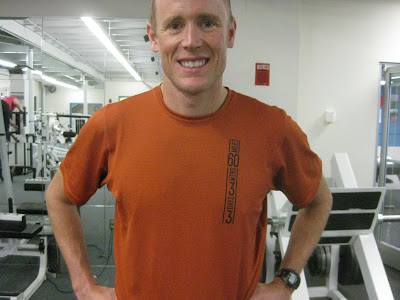
Author Stephen Taylor, in the gym.
This article is targeted to a year-round endurance athlete. If you are wanting to get in shape for the first time, this concept may be foreign.
Most endurance athletes appreciate the importance of strategy. You need to work hard towards your goals, do the right workouts, and persist on your efforts. I am going to describe a "big picture" strategy, which involves periodization. This concept means that you train differently at different times of the year. A systematic progression of key workouts will provide better results than a homogenous approach where training varies little from month to month.
The concept I want to highlight is that you should start now on building "Creeping Fitness."
For everyone except Australians and a few December marathoners, it is the off-season. Instead of hitting the cheetos bag, ice cream, and couch, you should be doing workouts that allow your fitness to creep. Likewise, don't just go do some more biking and running workouts. Make the switch-up described here. Don't let another year go by letting the resolution to get leaner and stronger pass you by. Start now by building the perfect foundation. Creep.

What workouts creep your fitness? It is exactly the workouts that you do not have time for during the period of formal training. When you are doing lots of conditioning training ( endurance and speedwork) there is little time for strength training, core abs and low back, and stretching. Do that stuff now. Find the muscles that haven't been worked all year. If you don't know where they are, I will show you using nothing more than a stretch band and stability ball.
"But I don't enjoy lifting weights," you might say. You don't like lifting weights because it is unfamiliar and you don't get "in the zone" when you do it. Get on a good strength program and stick with it long enough to see some results. I guarantee that you will be enjoying it by that time.
Continue doing some endurance training, but revert to a minimum baseline "maintenance" level. After you have "upped" your level of strength, then start increasing your endurance training. This is when you will truly feel the Fitness Creep. You will feel that you are not in peak fitness yet, but you will be fit. Very fit. That is the goal of the fitness creep: to gradually get into great fitness but in such a way that you can subsequently get into even better fitness.
Now keep in mind that while I am arguing for a period of strength/stretch emphasis, my true love is endurance. I don't care how much one can bench press, or how huge the deltoids are. The weight room is a highly effective means to an end.
The opposite of a Fitness Creep is the Short-Term-Fast-Payoff (STFP) approach. I have been a fitness trainer endurance coach for 10 years and I know all the STFP strategies. Do lots of high intensity intervals. Do explosive strength training before you have done an adequate period of strength-base training. Yes these strategies are appealing because you get fast results, but the crash is unpleasant. You plateau too fast. I coach my clients to reach their long term max potential, not a "12 week max results" approach in the middle of the off season.

If you implement a Fitness Creep you may initially be discouraged as it seems others are fitter than you. In January. But lay the proper foundation and you will be in the perfect position to do the really intense training required to get to your best preparation. You are getting ready to train, to get in shape. First things first.
Again, if you are out of shape right now, this may all sound greek to you. Creeping fitness? Periodization? What you need to know is that to get into really really great shape is a long term project that requires patience. Progress is not continuous. Rather, it involves periods of gains, followed by consolidation and even time off. Use a good strategy and expect the best.






















